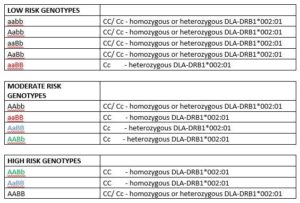Description: Dermatomyositis (DMS) is an autoimmune chronic inflammatory myopathy and vasculopathy, skin and muscle disease caused by a combination of environmental and genetic factors. DMS usually develops after activation of an environment such as vaccination or viral infection and is exacerbated by subsequent stressors. In accordance with the environmental trigger, the age of onset is variable. Many cases occur between 7 weeks to 6 months of age, but others develop only in adulthood. The first clinical signs of DMS are crusts and scales on the face, ears, tail tip and/or bony prominences of the limbs and feet. Alopecia and wider skin lesions may develop over time. Lesions last for weeks to months and may or may not recur chronically.
DMS has a significant association with three loci:
PAN2 (A); MAP3K7CL (B) and DLA-DRB1 (C).
Inheritance: Complex Inheritance
Mutation: PAN2 (A) – mutation g.627760G>A, encoding p.Arg492Cys;
gene MAP3K7CL (B) – indel (c.383_392ACTCCACAAA>GACT;
DLA-DRB1 – allele DLA-DRB1*002:01 (C), any other allele DLA-DRB1 (c)
A, B, C alleles – the risk of development of the dermatomyositis;
a, b, c – wild type alleles (without mutation)
Sample: EDTA whole blood (1.0 ml) or 2 buccal brushes. For official purposes, the confirmation of the dog’s identity by Veterinarian is recommended.
The analysis is suitable for the following breeds: Shetland Sheepdog, Collies, Smooth Collie, Rough Collie, Border Collie
Notes: It is recommended that mating should be done by selecting individuals according to their genotypes in the 3 genes tested. Ideally, matings that could produce puppies with high-risk genotypes should be avoided. The American Shetland Sheepdog Association has posted more information about the disease and the use of DNA test results on its website. They also provided DMS Genotype Calculator and Punnett Squares breeders with the use of test results to determine possible genotypes that could result from a particular breed.
